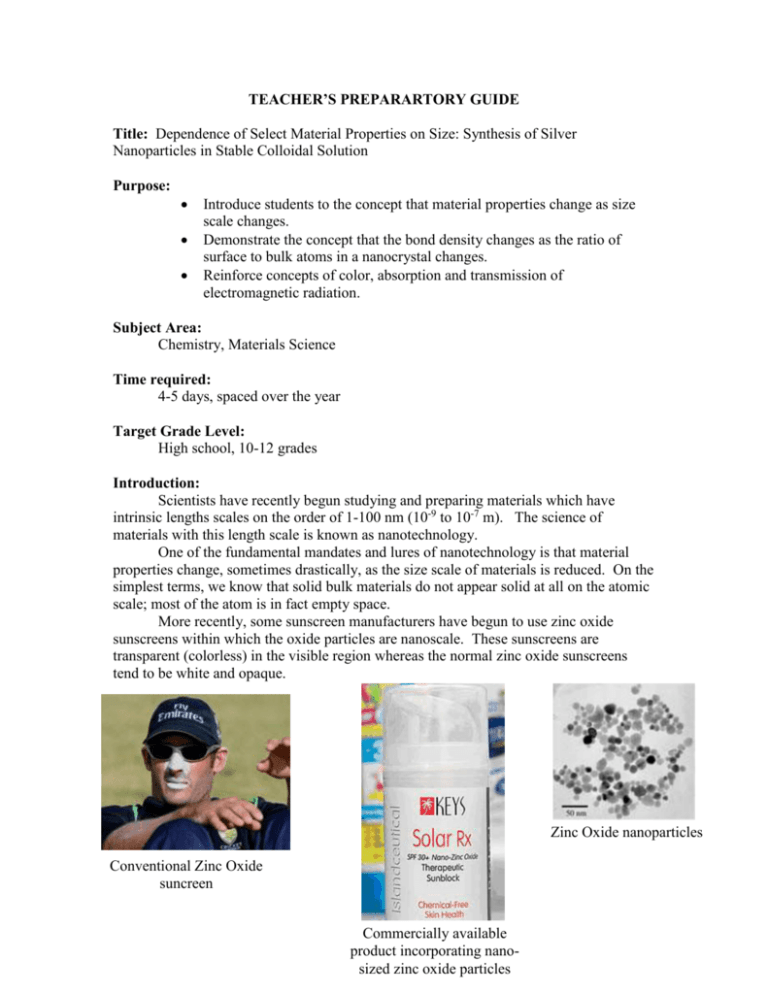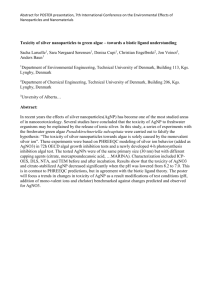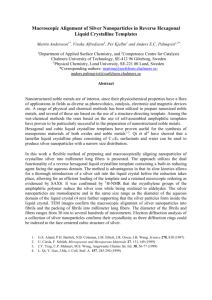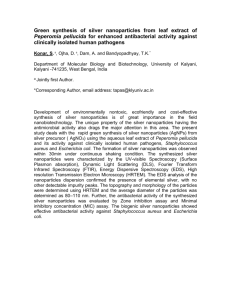teacherplan - University of Washington
advertisement

TEACHER’S PREPARARTORY GUIDE Title: Dependence of Select Material Properties on Size: Synthesis of Silver Nanoparticles in Stable Colloidal Solution Purpose: Introduce students to the concept that material properties change as size scale changes. Demonstrate the concept that the bond density changes as the ratio of surface to bulk atoms in a nanocrystal changes. Reinforce concepts of color, absorption and transmission of electromagnetic radiation. Subject Area: Chemistry, Materials Science Time required: 4-5 days, spaced over the year Target Grade Level: High school, 10-12 grades Introduction: Scientists have recently begun studying and preparing materials which have intrinsic lengths scales on the order of 1-100 nm (10-9 to 10-7 m). The science of materials with this length scale is known as nanotechnology. One of the fundamental mandates and lures of nanotechnology is that material properties change, sometimes drastically, as the size scale of materials is reduced. On the simplest terms, we know that solid bulk materials do not appear solid at all on the atomic scale; most of the atom is in fact empty space. More recently, some sunscreen manufacturers have begun to use zinc oxide sunscreens within which the oxide particles are nanoscale. These sunscreens are transparent (colorless) in the visible region whereas the normal zinc oxide sunscreens tend to be white and opaque. Zinc Oxide nanoparticles Conventional Zinc Oxide suncreen Commercially available product incorporating nanosized zinc oxide particles http://www.consumerreports.org/cro/health-fitness/nanotechnology-7-07/nanoparticlesin-sunscreens/0707_nano_sunscreen_1.htm http://science.howstuffworks.com/nanotechnology.htm/printable http://www.advancednanotechnology.com/zinc_oxide.php In this lab activity students will look at one property of silver which depends upon the size of the silver: its color. Since the mechanism by which the color depends upon size (and particle geometry) is more complicated than applicable for most high school classes, the mechanism of another material property which depends upon size is presented in an abstract manner. This lab also deals with concepts of redox reactions, colloidal solutions, interactions of light with matter (color, transmission, absorption, scattering) and stoichiometry. The lab could be used in conjunction with any of those topics as it is presented throughout the curriculum, and could be done early in the year and referenced later as the other topics arise, allowing a thematic nanotechnology link to the curriculum. Advanced Preparation Materials: Reagents Silver Nitrate, AgNO3 Trisodium citrate, C3H4OH(COO-Na+)3 Polyvinyl Pyrrolidone, PVP (MW 29k gmol-1) Sodium borohydride, NaBH4 H2O2 (3%) (stored in the fridge) The sodium citrate, sodium borohydride, and PVP are not standard chemicals in a high school laboratory but can be ordered from Sigma-Aldrich, or EMD. PVP: 234257 – 5G NaBH4 : SX0380-3 Trisodium Citrate: S4641 – 25G $24.50 $41.20 $18.10 Sigma-Aldrich EMD Sigma-Aldrich Equipment Glass Vials with lids Plastic Syringes or Micropipettes (Optional) Spectrophotometer Preparation of Stock Solution: 1) 1 mM AgNO3 stock solution Add 0.17 g of AgNO3 to a 1 L volumetric flask. Add enough deionized water to dissolve the silver nitrate, then add additional water to raise the solution volume to the white line. 2) 3 mM Trisodium Citrate solution Dissolve 0.44 g in 500 mL of DI water. 3) 0.7 mM PVP stock solution Dissolve 1.02 g in 50 mL of DI water. 4) 10 mM NaBH4 stock solution* Add 1.85 g of NaBH4 to a 500 mL volumetric flask. Add enough deionized water to dissolve the sodium borohydride, then add additional water to raise the solution volume to the white line. This makes a 100 mM solution. You will need to dilute this solution by a factor of ten. Save 50 mL of the 100 mM solution, rinse the volumetric flask thoroughly with deionized water, then combine the 50 mL of 100 mM NaBH4 with an additional 450 mL of DI water to form the 10 mM solution. * It is best to prepare a fresh solution of NaBH4 on the day of the synthesis. Note: we have found that avoiding contact between metals (i.e. spatulas) and the reagents is advantageous. You can use a Pasteur pipette to transfer small amounts of reagents. Safety Instructions Goggles are required for this laboratory. Silver nitrate can stain the skin. Due to the potential (although unlikely) for silver nanoparticles to pass through the skin, gloves should probably be worn. Waste chemicals should be collected and treated as hazardous waste due to the presence of nano sized materials. Directions for the Activity DAY ONE A. Depending on your normal approach, students may be assigned to complete a prelab for this activity. See the student worksheet which has answers and a sample data table. B. To introduce the activity on the day you begin, demonstrate the single replacement of silver ions in solution by a more reactive metal. Using a document projector, add 0.1 M AgNO3 to some magnesium metal filings. During the time that it takes you to introduce or remind the students of the concept of reduction and oxidation, silver will precipitate out onto the magnesium. You may collect the silver by filtering if you choose. Give students a chance to observe the bulk properties of silver, particularly its color. C. Run the laboratory. You may wish to allow students to pick the amount of NaBH4 added, or you may preselect the amounts you want different groups to add. It is probably best to have a range of colors available without explicitly telling the students why they are getting different results. Procedure (1,2): 1.) Label a 20 mL glass vial with your name. Using a glass graduated cylinder, measure 9 mL of deionized water and pour it into the vial. 2.) Using a plastic syringe, add 1.0 mL of 1.0 mM AgNO3 to the glass vial. 3.) Add 0.6 mL of 0.7 mM PVP using a plastic syringe into the vial. 4) Add 0.6 mL of 3 mM sodium citrate using a plastic syringe into the vial. 4.) Add 0.25 mL of 3% H2O2 using a plastic syringe in the same vial. 5.) Put the cap on the vial and invert several times in order to mix the reagents completely. 6.) Add Check with your teacher to determine how much of the 10 mM NaBH4 to add. Quickly cap the vial and begin to shake vigorously. (Record the amount of NaBH4 added to the vial.) 7.) The solution should turn a very pale yellow color at first (A good indicator that the synthesis is proceeding well). After shaking the vial for additional 5-10 minute, something very interesting should occur. Continue to shake for a full two minutes after the change occurs. Make sure to record your observations thoroughly. 8) Record the results of at least four other groups in the class in your data table. D. After students run the laboratory have them complete the post lab questions. Emphasize that these are exploratory questions; there are no right answers per se, and the questions are designed to get the students thinking about the color change they just saw and how it might relate to the introduction they’ve already read. E. You may choose to conduct a full class discussion to get at the answers some classmembers came up with. DAY TWO F. Today we want to get the students thinking about what was actually going on in the vials they used yesterday. There is a reading for the student with some questions interspersed. By the end of the reading and any class discussion which you conduct, we would like the students to know the following information. All the solutions contain silver, but the silver particles must be too small to be seen with the naked eye or with a normal microscope. The silver can be seen using a scanning electron microscope and we have some idea of the size and shape of the particles. The color must depend upon some material properties of the silver. Hopefully they can understand that the size of the nanocrystals is what determines the color of the nanoparticles, and that the physical properties of silver are fundamentally different on the nano- scale relative to the bulk sized scale. G. Why might properties depend on size? Students are asked to count the number of silver atoms versus the number of bonds for three nanocrystals of different sizes. It is important for you as the teacher to realize that this is a simplified model with some problems. In particular, the graphics represents a two dimensional slice of an FCC crystal of silver along the close packed <111> plane. Real crystals are obviously three dimensional structures. The nanoparticles shown as also much much smaller than those actually made in the lab. The nanoparticles made in the lab have sizes ~ 12 – 30 nm, and contain tens or hundreds of thousands of atoms. There is a powerpoint to go with the student handout. As an enrichment activity, you could ask students to predict the next numbers in the pattern as illustrated on the fourth slide in the powerpoint, or make a plot such as the one included in the powerpoint. Try to get students thinking about how having more surface atoms, or less bonds per atom on average, might influence properties such as melting point, chemical reactivity, and color. DAY THREE Section C for the students is a formative assessment. Students are asked to find out a bit of information about a commercially available product. Having learned that some material properties change as size scale changes, students should logically have some concerns about whether these products should be on the market without additional testing to determine the effects of the size of these nanomaterials on the environment and on human health. The criteria for a solid response are that 1) the student has obviously done some research on a product to figure out how it incorporates nanotechnology 2) the student has clearly recognized and stated in some manner that the properties of the nanomaterial may be different than that of the bulk material because of the size DAY FOUR Section D for the students should happen later, after you have talked about color, electromagnetic radiation, electron transitions, and light emission. The point of this activity is to get students thinking about where color comes from. You will need a spectrometer to measure absorbance spectra. You may also be able to use a spectroscope to view the wavelengths which are transmitted. A setup which could be used is shown below, but it is much more difficult to get results in this manner. White light/sunlight spectroscope sample White light source / sunlight There is a lot of potential in this module to go further. For the second question, you could make this into a lab assessment and actually test a variety of materials. For the extension, if you have discharge tubes or darklights you could test shirts/etc in order to see how the incident light affects perceived color. Teacher Background: Silver nitrate tends to stain the skin simply because silver is not a particularly reactive metal, and is easily reduced when in solution to produce solid silver. Only one electron is required to reduce Ag+ and this happens readily. In the demo with magnesium, the Mg metal has two valence electrons which it would really like to lose in order to have a full valence shell. It donates one electron to each of two silver ions. The magnesium is the reducing agent, and is oxidized to become Mg2+. The silver is reduced to become Ag (s). The synthesis of silver nanoparticles is easy to do once you have working solutions. Make sure to measure amounts carefully using glass to transfer reagents. The pale initial color is an excellent indicator that the reaction is working; if this color is not obtained your stock solutions are probably not good. After 5-10 minutes, the solution with rapidly change a dark yellow color, then shift in color through the spectrum of the rainbow until it settles on the final color. This final transformation usually takes no more than 1-2 minutes. The reaction is very sensitive to the stoichiometry of AgNO3 and NaBH4. Very small changes in the amount of NaBH4 produce large color changes. If the reaction initially turned pale yellow, but is not proceeding as expected, try adding additional 0.1 mL amount increments of 10 mM NaBH4, shaking vigorously for 2 minutes, to see if the reaction proceeds. The reduction of silver with sodium borohydride is not a particularly well understood reaction. Some of the details of the chemistry are glossed over in these documents. The mechanism of electron transfer is not quite clear, nor is the mechanism by which particle size is controlled. The method of colloidal stabilization (e.g. repulsion between silver nanoparticles surrounded by BH4- ions) is also simplified. The citrate ions and the PVP play a very important role in stabilizing the colloid. In particular, without the PVP, colloidal solutions tend to aggregate within days or weeks.4 The mechanism whereby different sizes of silver nanoparticles produce different colors is also a bit complicated. In general, we teach high school students that colors arise because of electron transitions between discrete allowed energy levels. Some materials emit light of a fixed color when excited as electrons transition from excited states to lower energy levels. Other materials absorb certain frequencies, reflecting or transmitting the other frequencies, again resulting in characteristic colors. The silver particles fall into the latter category, but the mechanism of absorption is not as simple as electrons moving to excited states. In metals, there are free electrons associated with the surface atoms. These electrons have different properties (wavefunctions, energy band diagrams, etc) because they are not in the bulk. Collectively, the surface atoms behave like a damped oscillating system. Incident electronmagnetic radiation causes the electrons to oscillate, but the oscillation is damped due to lattice “friction”, and some energy is lost as heat. The behavior is similar to a spring-dashpot system used in shock absorbers in cars. http://groups.physics.umn.edu/demo/old_page/demo_gifs/3A50_10.GIF These spring-dashpot systems have a particular frequency at which they oscillate with the larger amplitude. In the graph shown above, when the spring/dashpot system is forced to oscillate at just over 1 Hz, it has the largest response. We call this frequency the “resonant” frequency. At this frequency, the system absorbs the most applied energy. Similarly, when white light is incident on a metal, the surface electrons absorb light at the system’s resonance frequency. Light of this color is absorbed strongly, whereas other color tend to be transmitted. The phenomenon is called “surface plasmon resonance.” It happens for metals of all sizes, but is not a strong enough effect for bulk metals to be noticeable. But for nanoparticles, it dominates absorption. References 1. Yeechi Chen and Keiko Munechika, Jessica M. Smith, David S. Ginger, Dept. of Chemistry, University of Washington, Unpublished Results 2. Synthesis and Study of Colloidal Silver, Science in Motion curriculum, http://www.philasim.org/ 3. Solomon et. al. “Synthesis and Study of Silver Nanoparticles” J. Chem Ed. Vol 84 #2, February 2007 pg 322-325 4. “Rapid Thermal Synthesis of Silver Nanoprisms with Chemically Tailorable Thickness” G. S. Métraux, C. A. Mirkin Advanced Materials Volume 17, Issue 4, Date: February, 2005, Pages: 412-415








